Complete Solutions to LEVEL-V of chapter CARBONYL COMPOUNDS of Class 11 book with complete answers and questions
| Class 11 | CHEMISTRY |
| Chapter | CARBONYL COMPOUNDS |
| NARAYANA | LEVEL-V |
| Number Of Questions | 99 |
| Academic Year | 2023-24 |
Reaction of cyclohexanone with dimethylamine in the presence of catalytic amount of an acid forms a compound if water during the reaction is continously removed. The compound formed is generally known as
View SolutionIn a Cannizaro reaction the intermediate that will be the best hydride donor is
View Solution
Products is
View SolutionIn the reaction `CH_(3)CHO+CH_(3)COCH_(3)`with base , how many distinct aldol products are possible ?
View SolutionThe product obtained by reaction of PhCHO & MeCHO in basic medium are :
View Solution`CH_(3)CHO+NH_(2)OHto CH_(3)CH=N-OH` The above reaction is carried out at
View SolutionThe product A and B in the reaction given below are :
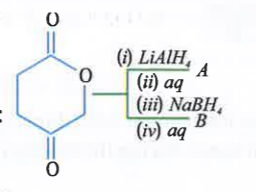
View Solution
is the final product obtained when one of the following reacted with base .
View SolutionEnd product of the following sequence of reaction is `CH-=CHoverset(CH_(3)MgBr)tooverset(CO_(2)//H_(3)O^(+))tooverset(HgSO_(4)//H_(2)SO_(4))tooverset(Ag_(2)O)underset(Delta)to`
View SolutionWhich of the following are examples of aldol condensation ?
1.`2CH_(3)CHOoverset(dil. NaOH)to CH_(3)CHOHCH_(2)CHO` . `2CH_(3)COCH_(3)overset(dil. NaOH)to CH_(3)COCH(CH_(3))CH_(2)COCH_(3)`
3. `2HCHOoverset(dil. NaOH)to CH_(3)OH+HCOOH`
4. `C_(6)H_(5)CHO+HCHOoverset(dil. NaOH)toC_(6)H_(5)CH_(2)OH`
View SolutionMatch list I (reaction) with list II (Reagent) and select the correct answer using the codes given below :

View SolutionMononitration of phenyl benzoate gives the major product :
View SolutionIdentify the final product

View SolutionIn the reaction

`overset(NaOH//200^(@) C)to overset(H^(oplus)//H_(2)O)to` the major product is :
View SolutionIdentify the product (B)

View SolutionWhich of the following reagent on reaction with conc. `NaOh` followed by `H^(oplus)` gives following easter ?

View Solution
View Solution
A+B Compound (A) and (B) can be differentiated by :
View Solution
Above compounds can be differentiated by following reagent :
View SolutionRank the following in order of increasing value of the equilidrium constan for hydration, ` K_(hyd)`.
 ,
,
View Solution`Ph-overset(O)overset(||)(C)-CH_(3) overset(NaNO_(2))underset(HCl)(to) (A) underset("heat")overset(AC_(2)O)(to) (B)overset(H_(3)O^(+))(to)(C)`
Product (C) of the above reaction is :
View Solution
Positive Tollens test Compound (A) is :
View SolutionWhich of the following pairs of reactants is most effective in forming an enamine ?
View Solution
Product ( C ) of the reaction is
View SolutionIn the reaction , the acid obtained will be :
`CH_(3)CHO + HCN to CH_(3)CH(OH)Cnoverset(H-OH)(to) CH_(3)CH(OH)COOH`
View Solution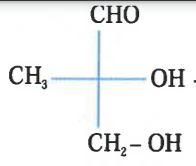
`underset((ii)H^(+))overset(("i")HCN)to` Product , Product obtained in the reaction is : D-(+) - Glyceraldelyde
View SolutionComplete the following reaction

View Solution
The correct order of decreasing value of ` K _(eq)` is :
View Solution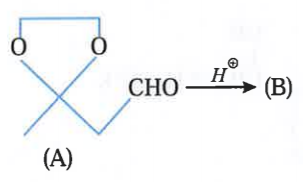
(A) & (B)` are isomers , Isomer (B) is :
View Solution`CH_(3)-overset(O)overset(||)(C)-Hoverset(HCN)(to)(A)overset(H_(3)O^(o+))(to) (B)underset(Delta)(to)(C)overset(LiAlH_(4))(to)(D)overset(HIO_(4))(to)HCHO` + (E)`
Compound (C) can show geometrical isomerism . Product (E) of the reaction will be :
View Solution
View SolutionMethyl ketone on reaction with `LiCuMe_(2)` gives a major product , whose structure is :
View SolutionWhich of following is in capable to show iodoform test ?
View Solution
Structure of is :
View Solution
Relation between `K_(1)` and ` K_(2)` is :
View Solution . Compounds is : C. Compound ( C) is :
. Compounds is : C. Compound ( C) is :
View Solution product A is :
product A is :
View SolutionThe enolate ion that reacts with 3- buten-2- one to form (Y) is :

View Solution(A)`overset(O_(3))underset(Zn//AcOH)to(B) +(C ) C_(7)H_(14)` Compound (A) exist in geometrical isomers and (B) Cannizaro reaction. (A) will :
View Solution
`overset(HO^(-))underset("(conjugate-addition")to`(A) , product (A) is :
View Solution`CH_(3)-overset(OH)overset(|)(C)H-CH_(2)-overset(O)overset(||)(C)-Hunderset(("Reduction aldol"))overset(HO^(-))to(A),3HCHO+Aunderset(40^(@)C)overset(Na_(2)CO_(3))tounderset((82%))(B)`
Product (B) of the above reaction is:
View SolutionBase catalysed aldol condensation occurs with
View SolutionWhich of the following compounds will give a yellow precipitate with iodine and alkali ?
View SolutionWhich of the following will undergo reaction with Alcoholic Choloroform
View Solution`CH_(3)-CHOoverset(NaOH)rarrCH_(3)CH(OH)CH_(2)CHO`
In the aldol condensation of acetaldehyde represented above, which of the following intermediate species as obtained?
View SolutionWhich of the following compounds will give a red precipitate on being heated with Fehling 's solution.
View SolutionWhich of the following reactants on reaction with conc. NaOH followed by acidification gives following lactone as the main product ?

View SolutionSuggest appropriate structures for the missing compounds. (The number of carbon atoms remains the same throughout the reactions). Compound (A),(B) & ( C) can be

View SolutionAn organic compound (A) reacts with `H_(2)` to give (B) and ( C) successively. On ozonolysis of (A) , two aldehydes (D) `C_(2)H_(4)O` and ( E) ` C_(2)H_(2)O_(2)` and On ozonolysis of (B) only propanal is formed. Compound (A), (D) & ( E) are
View SolutionAn unknown compound of carbon , hydrogen and oxygen contains 69.77 % C and 11. 63% H, and has a molecular weight of 86 . It does not reduce Fehling solution but forms a bisulphate addition compound and gives a positive iodoform test. What are possible structures is
View Solution Product can be
Product can be
View SolutionAcetophenone can participate in
View Solution`CH_(3)CHO` can be converted into carboxylic acid salt by using
View Solution`CH_(3)-CHO` can be participated in
View SolutionWhich compound (s) on reaction with `overset(Theta)(OH)` can give two organic products (excluding stereoisomers)?
View SolutionThe reaction is oxidation - reduction type and takes place in presence of 50% aqueous or ethanolic alkali One molecule of the aldehyde (missing of a- hydrogen atom )oxidizes, to corresponding carboxlic acid and the other is being reduced to the corresponding alcohol.

Mechanism : the mechanism involves two distinct steps Nucleophilic attack and hydride ion transfer.


View SolutionThe reaction is oxidation - reduction type and takes place in presence of 50% aqueous or ethanolic alkali One molecule of the aldehyde (missing of a- hydrogen atom )oxidizes, to corresponding carboxlic acid and the other is being reduced to the corresponding alcohol.

Mechanism : the mechanism involves two distinct steps Nucleophilic attack and hydride ion transfer.


View SolutionThe reaction is oxidation - reduction type and takes place in presence of 50% aqueous or ethanolic alkali One molecule of the aldehyde (missing of a- hydrogen atom )oxidizes, to corresponding carboxlic acid and the other is being reduced to the corresponding alcohol.

Mechanism : the mechanism involves two distinct steps Nucleophilic attack and hydride ion transfer.


A. The A is
View SolutionAldehyde, ketone, carboxylic acid derivatives contain C= O group. Aldehyde and ketones give nucleophilic addition reactions where as acid and acid derivatives give nucleophilic addition followed by elimination reactions. Nucleophilic addition reactions followed by elimination of acid dervatives is Known sacyl substitution reaction. This substitution reaction takes place by formation of tetrahedral intermediate. For the given reaction
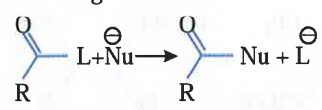
which of these is correct ?
View SolutionWhich one the following compounds has very poor leaving froup?
View SolutionWhich one of the following is least reactive compound for nulceophilic acyl aubstitution.
View SolutionA tertiary alcohol (H) upon acid-catalysed dehydration gives a product (I). Ozonolysis of (I) leads to compounds (J) and (K). Compound (J) upon reaction with KOH gives benzyl alcohol and a compound (L), whereas (K) on reaction with KOH gives only (M).
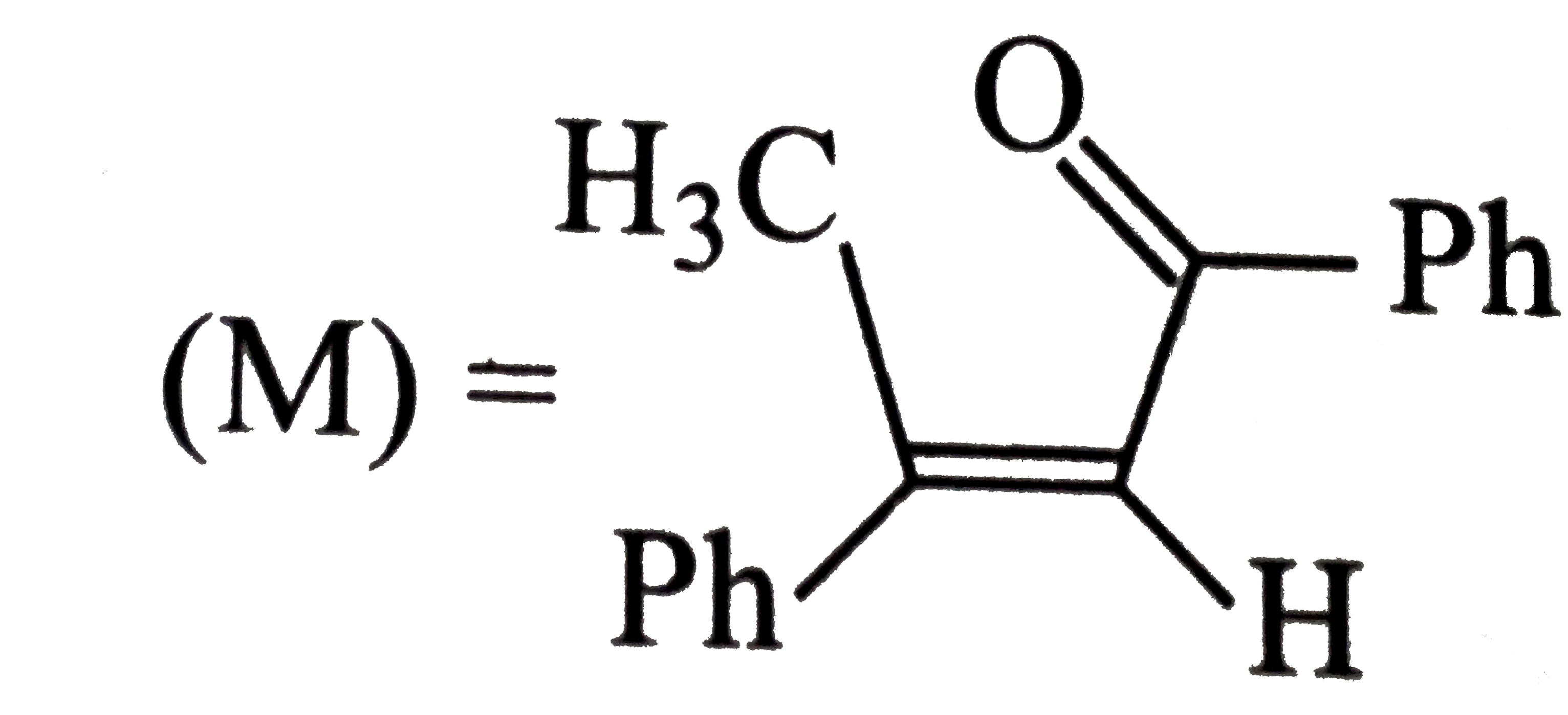
The structurer of compound (I) is:
View SolutionA tertiary alcohol H upon acid- catalyzed dehydration gives a product I. Ozonolysis of to compounds J and K. Compound J upon reaction with KOH gives benzly alcohol and a compound L, whereas K on reaction with KOH gives only M.

The structure of compound I is
View SolutionA tertiary alcohol H upon acid- catalyzed dehydration gives a product I. Ozonolysis of to compounds J and K. Compound J upon reaction with KOH gives benzly alcohol and a compound L, whereas K on reaction with KOH gives only M.

The structures of compound J,K and L respectively , are
View Solution
The compound P is :
View Solution The compound Q is :
The compound Q is :
View Solution
The compound R is :
View SolutionObserve the following reaction : `Ar-C-Hoverset(OH^(-))hArr[X]overset(Ar-overset(O)overset(||)C-H)hArr[X]+[Z] overset(H^(+)"Transfer")hArrY^(1)+Z^(1)`
The slowest step of the reaction is :
View SolutionObserve the following reaction : `Ar-C-Hoverset(OH^(-))hArr[X]overset(Ar-overset(O)overset(||)C-H)hArr[X]+[Z] overset(H^(+)"Transfer")hArrY^(1)+Z^(1)`
Rate of step -2 will be fastest with the combination of :
View SolutionObserve the following reaction : `Ar-C-Hoverset(OH^(-))hArr[X]overset(Ar-overset(O)overset(||)C-H)hArr[Y]+[Z] overset(H^(+)hArrY^(1)+Z^(1)`
In step -3 if Y transfers `H^(-)` ion to Z, then Y' and Z' are respectively :
View Solution`P+Qoverset(Aq.K_(2)CO_(3))underset(Delta)toRoverset(HCN)toSoverset(H_(3)O^(+))underset(Delta)toPh=CH-underset(OH)underset(|)CH-COOH`
The compounds P and Q are :
View Solution`P+Qoverset(Aq.K_(2)CO_(3))underset(Delta)toRoverset(HCN)toSoverset(H_(3)O^(+))underset(Delta)toPh=CH-underset(OH)underset(|)CH-COOH`
The compound R is :
View Solution`P+Qoverset(Aq.K_(2)CO_(3))underset(Delta)toRoverset(HCN)toSoverset(H_(3)O^(+))underset(Delta)toPh=CH-underset(OH)underset(|)CH-COOH`
The compound S is :
View Solution
The structure of alkene (P) is
View Solution
The structure of product ( R ) is
View Solutionmatch the following

View SolutionMatch the following?

View SolutionMatch compound of List -I with pKa of List -II

View SolutionAldol condensation proceeds by carbon- carbon bond formation between an enolation donor and a carbonyl acceptor For each of the following aldol products (1 through 4)

Match the donor and acceptor compound.

View SolutionMatch the compounds// ions in Column- 1 with their properties in Column -2

View SolutionMatch the reaction in column I with appropriate type of steps// reactive intermediate involved these reaction as given in column II.

View SolutionColumn I Column II

View SolutionSTATEMENT -1: Aldehydes are more Reactive then corresponding ketone for Nucleophillic reactions
STATEMENT -2: Due to electron density at functional group carbon which is higher in ketone than in Aldehyde.
View SolutionSTATEMENT -1: When Ph -CHO is treated with conc. `OH^(-)` , formation of `PhCH_(2)` OH and ` PhCOO^(-)` takes place.
STATEMENT -2:It involves hydride transfer, hence one molecule is reduced and another is oxidized.
View SolutionSTATEMENT -1: HCHO is more reactive then `CH_(-3)COCH_(3)` towards nucleophilic addition reaction
STATEMENT -2: In `CH_(3)COCH_(3),- `CH_(3)` shows -I effect
View SolutionSTATEMENT -1: Alphatic Ketone are Less reactive then aliphatic aldelyde
STATEMENT -2 :Rate of Electrophillic addition and substitution in aliphatic aldehyde is faster then aliphatic ketones
View SolutionSTATEMENT -1: Rate of Nucleophillic addition of p- Nitrobenzaldehyde is faster then p- Methoxybenzaldehyde
STATEMENT -2: Presence of electron withdrawing group increases rate of Reactionn in carbonyl compound for Nuclephillic reaction.
View SolutionSTATEMENT -1: Boiling point of ketones is higher then corresponding Aldehyde.
STATEMENT -2 : Dipolemoment of Aldehyde is higher then Ketone.
View SolutionSTATEMENT -1: Cannizzaro reaction Methanal & Benzaldehyde forma Methanol and Benzoic acid salt
STATEMENT -2 : Methanal is more reactive then Benzaldehyde
View SolutionSTATEMENT -1: Amixture of
 on treatment with dil . `NaOH` gives
on treatment with dil . `NaOH` gives 
STATEMENT -2 : The ketone is very hindered and conjugated and so less reaction than aldehyde.
View SolutionSTATEMENT -1: The addition of amines in aldehyde and ketone is carried out in weakly acidic medium
STATEMENT -2 : In strong acidic medium amines will protonated the nucleophilic character of amine decrease.
View SolutionSTATEMENT -1: RCOCl fails to give ketone with RMgX
STATEMENT -2 : RCOCl give ketone with `R_(2) Cd`
View SolutionComplete the following reactions and findout number of carbon atmos present in compound (D)

View SolutionThe rate equation found in Benzillic acid -Benzil rearrangement is `rate=k[Ph-CO-CO-Ph]^(a)[OH^(-)]^(b)`then a+b is
View SolutionAn organic compound 'A' on treatment with ethyl alcohol gives a carboxylic acid 'B' and compound 'C'. Hydrolysis of 'C' under acidic conditions gives 'B' and 'D' . Oxidation of 'D ' with `KMnO_(4)` also gives 'B' . 'B' on heating with ` Ca(OH)_(2)` gives 'E' `(C_(3)H_(6)O). E does not give Tollen 's test and does not reduce Fehling 's solution but form a 2,4- dinitrophenyl hydrazone . How many carbon are present in product (E ).
View SolutionThe commonly observed ratelaw of Benzoin condensation is rate = `K[ArCHO]^(x)[CN^(-)]^(y)` Then the value of x+y is
View SolutionThe order of Canizzarro ' s reaction when base concentration is high.
View SolutionDuring Perkin ' s reaction , a cyclic intermediate is formed. The no . Of atoms in the newly formed ring is
View SolutionIn Witting reaction, a cyclic intermediate is formed called oxaphosphetane. The no. of atoms involved in the ring formation.
View Solution
LEVEL-V questions and complete solutions for chapter CARBONYL COMPOUNDS of NARAYANA CHEMISTRY (HINGLISH) of Class 11